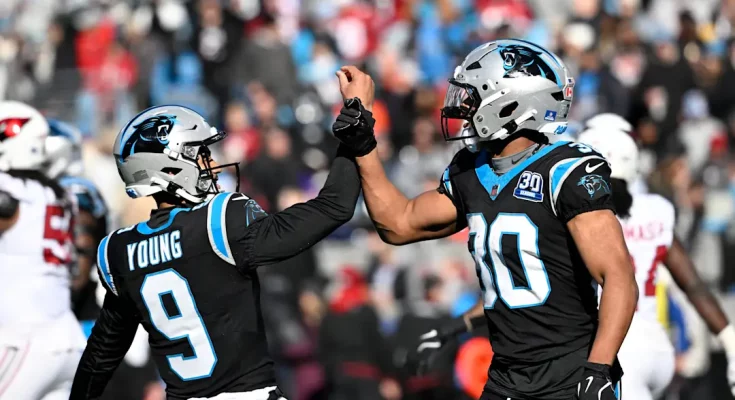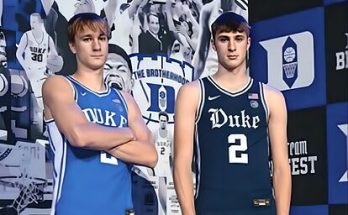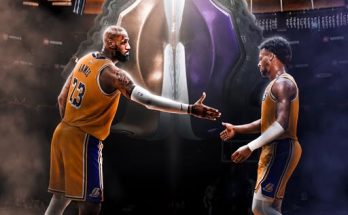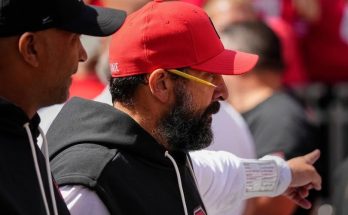The Carolina Panthers have endured more than their fair share of struggles over the last few seasons, especially when it comes to the offensive side of the football. After years of shuffling through quarterbacks, inconsistent offensive line play, and skill positions lacking star power, the franchise finally seems to have found a blueprint worth believing in. At the heart of that vision is a young core built around three dynamic players: Bryce Young, Tetairoa McMillan, and Chuba Hubbard. While the entire offense must function cohesively for any team to succeed, these three represent the most critical pieces in Carolina’s puzzle. Each brings a unique skill set to the field, and when utilized correctly, their synergy could very well change the identity of the Panthers’ offense for years to come.
Bryce Young enters the 2025 NFL season with the weight of the franchise on his shoulders. Drafted first overall by the Panthers in the 2023 NFL Draft, Young came into the league as one of the most decorated quarterbacks in recent college football history. A Heisman Trophy winner at Alabama, Young was praised for his poise, intelligence, accuracy, and leadership—traits that immediately drew comparisons to other cerebral quarterbacks like Drew Brees and Russell Wilson. However, his rookie campaign was nothing short of turbulent. Poor offensive line play, lack of elite wide receiver talent, and a coaching carousel left Young scrambling—not just on the field but figuratively to find his footing in the league. Despite the adversity, there were flashes of brilliance, windows into what made him the top pick. Whether it was his quick release under pressure, the anticipation on out routes, or the touch on deep throws, Young showed he had the necessary tools.
Fast forward to 2025, and things have changed. Carolina has invested heavily in building around him. A revamped offensive line, a more competent play-calling structure under a new offensive coordinator, and, most importantly, the addition of legitimate weapons have created a much healthier environment for Young to flourish. No longer is he being asked to make magic behind a collapsing pocket or force throws into double coverage because his receivers couldn’t separate. With Tetairoa McMillan in the fold and Chuba Hubbard continuing to assert himself as a dual-threat back, the conditions are ripe for Young to evolve from potential into production.
Tetairoa McMillan, affectionately known as “T-Mac” by fans and teammates alike, is an absolute game-changer. The Panthers drafted him with the clear intention of giving Young a true WR1—someone with the size, hands, and catch radius to open up the entire field. At 6-foot-5 with a background in track and volleyball, McMillan brings not just athleticism but spatial awareness and timing that are elite even by NFL standards. His college career at Arizona was spectacular, culminating in a dominant final season where he posted over 1,400 receiving yards and double-digit touchdowns. He thrived on contested catches and was a terror in the red zone. But what makes McMillan truly special is how well he fits with Bryce Young’s skill set. Young doesn’t have the biggest arm in the league, but he’s exceptional at throwing receivers open, anticipating breaks, and placing the ball where only his guy can get it. McMillan, with his large catch radius and body control, is almost tailor-made for that style of quarterback play.
Their chemistry is already being talked about by coaches, beat reporters, and even opposing players. Whether it’s the timing on back-shoulder fades or the synergy on slants against zone coverage, the connection is clear. McMillan’s ability to win on all three levels of the field gives the Panthers a level of offensive flexibility they’ve lacked for years. His presence stretches the defense, forces safeties to play deeper, and opens up the intermediate routes for slot receivers and tight ends. And that leads to the third piece of this triangle: Chuba Hubbard.
Chuba Hubbard’s journey to becoming a crucial offensive piece has been anything but linear. A former star at Oklahoma State, Hubbard burst onto the scene in college with a 2,000-yard rushing season, showcasing elite straight-line speed and explosive acceleration. But the NFL is a different animal, and his early years in Carolina were marked by inconsistency, limited carries, and questions about whether he could ever be a lead back. However, in recent seasons, Hubbard has undergone a transformation. Improved patience, vision, and pass protection have all contributed to him becoming not just a dependable player, but a centerpiece of the offensive game plan. He’s now a legitimate threat in both the run and passing games.
What makes Hubbard particularly vital to this offense is the balance he provides. While Young and McMillan represent the vertical, high-reward aspects of the passing game, Hubbard is the steadying force. His ability to gain tough yards between the tackles keeps the chains moving, and his presence in the backfield forces defenses to respect the run. That opens up play-action opportunities, something Young excels at. Furthermore, Hubbard’s improved route running and reliable hands have made him a favorite target on checkdowns and designed screens. His acceleration in the open field can turn a modest gain into a game-changing play.
But beyond the raw talent, what binds these three players together is their complementary nature. This is not a trio that thrives individually at the expense of the other. Instead, each player’s skill set enhances the effectiveness of the others. Bryce Young’s processing and decision-making are maximized when he knows he has a trustworthy target like McMillan who will make contested catches and run crisp routes. McMillan’s ability to stretch the field and command double-teams gives Young clearer windows, while Hubbard’s rushing success forces defenders into the box, limiting exotic coverage schemes and opening passing lanes. It’s the kind of interdependence that can’t be engineered overnight—it’s developed through reps, trust, and coaching.
This also brings into focus the Panthers’ overall offensive philosophy. Under the new regime, the team has made it clear they want to be adaptable. They’re not married to one rigid scheme. Instead, they want to morph their game plan each week based on opponent weaknesses, and this trio allows them to do just that. Against a team with a porous secondary, the Panthers can unleash the vertical attack with Young and McMillan. When facing a dominant defensive line or needing to control time of possession, Hubbard becomes the workhorse. And when the game calls for balance, all three work in harmony to keep the defense guessing.
Another underappreciated aspect of this offensive trio is their leadership. Though still relatively young in their NFL careers, all three have shown maturity beyond their years. Young is already one of the most respected voices in the locker room. McMillan, despite being a rookie, has a work ethic and quiet confidence that resonates. And Hubbard, having been through ups and downs, now serves as a role model for younger players entering the league. Their collective demeanor sets the tone for the rest of the offense—focused, disciplined, and unselfish.
The road to becoming an elite offense won’t be easy. The NFC South remains competitive, with teams like the New Orleans Saints and Atlanta Falcons always looming. And injuries, inconsistency, or regression can derail even the most promising cores. But if the Panthers are going to take a leap forward—if they’re going to go from rebuilding to contending—it will be because these three players elevate themselves and each other.
There’s also something to be said for the long-term potential of this group. In today’s NFL, continuity is rare. Coaching staffs change, players demand trades, and free agency can rip apart a promising unit in an instant. But Carolina has the opportunity to build something lasting. Young is on a rookie contract. McMillan will be for years. And Hubbard, still relatively young himself, is under team control for the foreseeable future. This creates an environment where chemistry can deepen, playbooks can expand, and leadership hierarchies can solidify.
If the Panthers play their cards right, we may look back at this era as the foundation of something great. Not just a few winning seasons, but sustained excellence. And it won’t be because of a flashy free agent signing or a gimmicky offensive scheme. It’ll be because the team believed in its young nucleus, nurtured its development, and allowed its brightest stars to shine in concert.
As training camp progresses and preseason games begin, the eyes of Panther Nation will be on these three. Fans will watch every throw from Young, every route from McMillan, every cut from Hubbard. But more importantly, they’ll be watching for signs that this offense is more than just a collection of talent. They’ll be looking for chemistry, execution, and that intangible feeling that something special is brewing.
And make no mistake, something is. Because in Bryce Young, the Panthers have their field general. In Tetairoa McMillan, they have their go-to playmaker. And in Chuba Hubbard, they have their engine. Together, they don’t just form the heart of the offense—they define its soul. And if they continue to grow together, they might just give Carolina fans what they’ve been yearning for since the glory days of Cam Newton: an offense that not only excites but wins.
That’s the hope, the plan, and perhaps soon, the reality.



